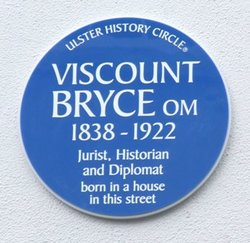"Hae" [Hay] Meaning: Have
James Viscount Bryce (1806-1877)

James Bryce was born in 40 Arthur Street, Belfast on 10th May 1838, the eldest son of James Bryce (1806-1877), who was teacher of mathematics at Belfast Academy. The Bryce family had been bonnet lairds (landowning farmers) in Dechmont, near Coatbridge in Lanarkshire but they lost most of their land as a result of supporting the Covenanting cause.
Bryce’s grandfather, James Bryce the elder (1767-1857) was a Presbyterian minister who came over from Scotland to Killaig, outside Coleraine, in 1805. His son James married Margaret Young, daughter of the Belfast merchant James Young of Abbeyville.
As Ulster-Scots the Bryce’s were part of that Presbyterian enlightenment which had its issue in the United Irishmen and in the political ideas of William Drennan and Henry Joy McCracken: a political community which was virtually indivisible from the covenanting radicalism of South West Scotland.
In 1847, Bryce went to study at the High School of Glasgow, where his father had been appointed Mathematics and Geography Master. He returned home in 1852 to study at Belfast Academy under his uncle, Reuben John Bryce, (who was Headmaster of the school for over 50 years), before entering the University of Glasgow the following year. In 1857 he went on a scholarship to Trinity College, Oxford, graduating BA in 1862 (as a non-Anglican, he was barred from taking an MA).
Bryce retained a lifelong commitment to Liberalism, consistent with his Ulster-Scots roots. In the 1860s he campaigned for the reform and extension of Oxford University (including the scrapping of religious tests); and was a founding member of Girton College, the first female college at
Cambridge.
He was called to the bar and practised in London for a few years, but soon returned to Oxford as Regius Professor of Civil Law, a position he held between 1870 and 1893. He founded the Law Quarterly Review in 1883 and (with Lord Acton) the English Historical Review in 1885.
He entered Parliament in 1880 as Liberal MP for Tower Hamlets in London. In 1885, he was returned as MP for the safe seat of South Aberdeen, which he held for the next 22 years. Various posts in the Liberal governments of Gladstone and Campbell-Bannerman followed, including Chancellor of the Duchy of Lancaster (1892); President of the Board of Trade (1894–95); and Chief Secretary for Ireland (1905-1907). King Edward VII appointed Bryce as a Member of the Order of Merit (O.M.) in 1907.
Throughout his career, James Bryce authored an impressive range of publications. By far his best known work is The American Commonwealth, published in 1888, a thorough examination of the constitutional system of the United States, which became a standard work on the subject. His unsurpassed knowledge of the U.S. and his excellent links with academics and politicians there led to his appointment in 1907 as British Ambassador in Washington DC, a post he held for seven years. During his tenure he improved UK-US relationships, due as much to his popularity among the American people as his relationships with Presidents, although he did share strong affinity with Woodrow Wilson, another Ulster-Scots Presbyterian, who entered the White House in 1913.
On his return from Washington, Bryce was raised to the peerage as Viscount Bryce of Dechmont. He was also appointed to the International Court at The Hague. Following the outbreak of the First World War, he was asked by Prime Minister Asquith to prepare the official report into German atrocities in Belgium, which was damning of attacks on Belgian civilians. The following year, he spoke out strongly against Turkish genocide against the Armenians in the Ottoman Empire; and with the assistance of the historian Arnold J. Toynbee, he produced a documentary record of the massacres, published by the British government in 1916 as the Blue Book.
In his earlier life, Bryce was a notable mountain climber, the first European to climb Mount Ararat in 1876. He climbed all over the world and was President of the Alpine Club from 1899 to 1901. Mount Bryce in the Canadian Rockies is named in his honour. Appointed as a Fellow of the Royal Society in 1894; he was President of the British Academy from 1913 to 1917.
Viscount Bryce died on 22 January 1922. His memorial service was held at Westminster Abbey. After cremation, his remains were interred in Edinburgh.

